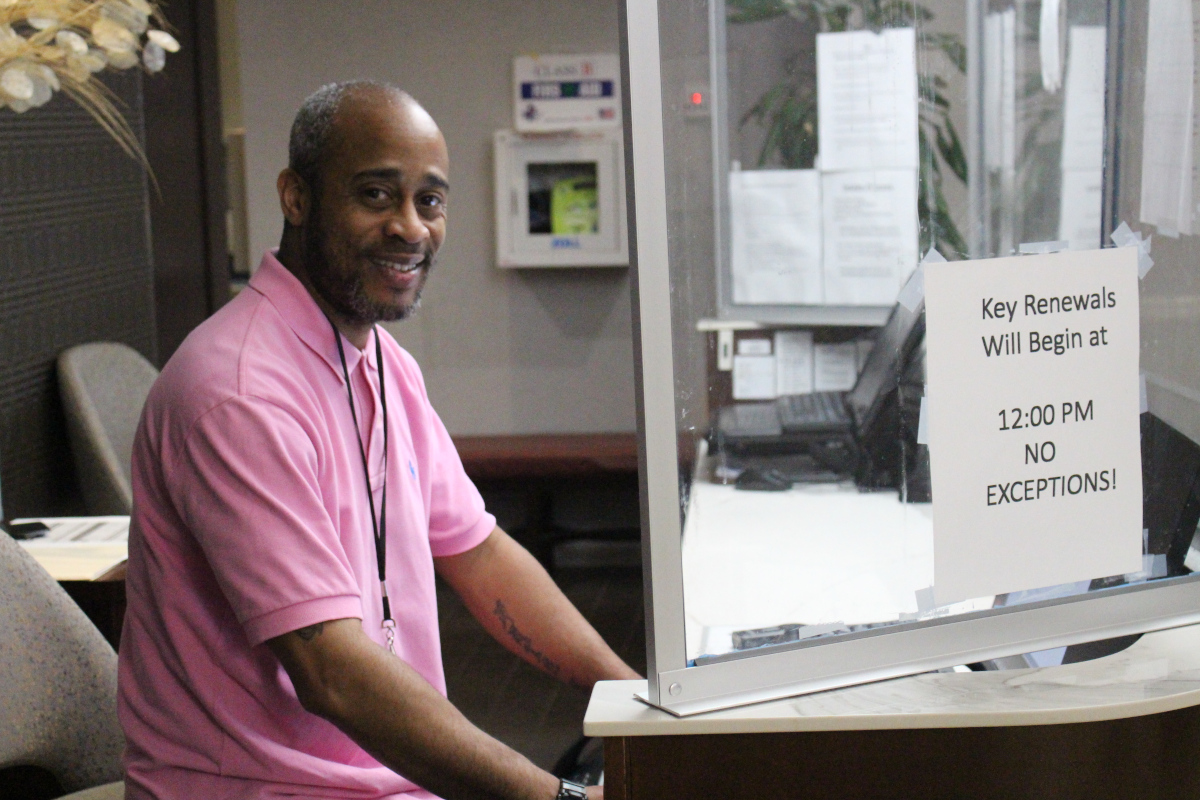While Wilmington’s streets are often teeming with lawyers and bankers shuttling between meetings at the various high-rises around the city, there are hundreds of people with seemingly nowhere to go.
On the nicest days, the city’s homeless populate public areas like Christina Park or Rodney Square as well as the few city drop-in centers like the Creative Vision Factory. On colder days, many head to the Wilmington Public Library.
Each year, tens of millions of dollars are spent between a multitude of government agencies and nonprofits to shelter and feed the city’s homeless, secure housing for those in need and provide a litany of social and behavioral health services to those who will accept the aid.
Those who work inside that network concede that the patchwork of funding sources often places disadvantageous restrictions on the services they can provide, but the diversity of sources also allows them to survive should one be lost.
And for those who are in need of the services, the varying barriers to entry with each program makes navigating a route to help difficult as well.
Melissa Brittingham had struggled for years with drug addiction and, after her longtime boyfriend died of cancer last year, she found herself back on the streets.
She was initially taken in at a city shelter for women, but wasn’t eligible under its guidelines to stay more than a few days. After talking with someone at a recovery meeting, she was linked to New Castle County’s Hope Center, where she has spent the last two months working with a case manager and finding a new apartment.
Brittingham will move into her own home on May 31 with eight months sobriety, thanks in part to the network of services around the city.
“I’m doing good here. I get something done every day, whether it’s making calls or meeting with my case manager,” she said. “They gave me survival tools and now I’ve got to go spread my wings.”
The ongoing drug crisis plays an outsized role in homelessness
While advocates would love to see the homeless take advantage of resources like Brittingham, the reality is that mental illness, substance abuse disorder and a lack of affordable housing play parts in keeping people trapped in a cycle of housing insecurity.
The annual Point-In-Time survey identified 1,245 homeless residents in Delaware last year – the largest number identified in the 17-year history of the survey outside of the COVID era years that saw inflated figures.
The Rev. Thomas Laymon, president and CEO of the Sunday Breakfast Mission, one of the largest overnight shelters for the homeless in the city that is entirely self-funded, said that he’s seen their population tick back to above pre-pandemic levels. They are averaging nearly 25% more guests than average right now, and women and children are a big part of those growing numbers.
“When I came to the Sunday Breakfast Mission 21 years ago, we would have 30 to 40 guys who would come in nightly, we now have 130 to 150. After we opened the women and children’s shelter in 2011, we might have five or 10 or 15 in a night. Now it is not unusual to have 45 to 50 women and children overnight,” he explained.
Laymon said the continuing drug crisis plays an outsized role in how and why people or their family members become homeless. As illicit drugs — especially synthetic opiates like fentanyl — have become increasingly potent and deadly, many are finding it harder to shake their addictions.
“We see more people in the overnight shelter because people are breaking all their relationship ties due to their addictions,” he said.
Michael Kalmbach, the executive director of the Creative Vision Factory, a drop-in art studio that serves the city’s homeless, said that sadly many of his participants died from COVID in the pandemic. Their participation numbers have not declined, however, as a new generation of young homeless residents – some not even 20 years old – have arrived at his door.
The 2021 indictment and bankruptcy of Connections Community Support Programs, then a major mental health and substance use treatment provider throughout Delaware, only further strained the city’s service network, he noted.
“It was a perfect storm. [Connections CSP] was like our cavalry because they were so big,” Kalmbach said, noting most of their members had contact with the nonprofit in some way.

Michael Kalmbach, the executive director of the Creative Vision Factory. (Jacob Owens/Spotlight Delaware)
He recounted how one of the CVF’s artists who has lived on Social Security Disability Insurance his entire adult life was given his patient files by Connections CSP after their bankruptcy and forced to navigate the system on his own.
“We went to see him and there was like a literal hole in his apartment, where you could climb to the outside, and his front door didn’t lock. Those were the conditions we found him in and it took us basically the entirety of the pandemic era to connect those dots again to get him proper housing,” Kalmbach said.
The Hope Center gives people experiencing homelessness a place to sleep, rebuild
At the height of the pandemic, New Castle County Executive Matt Meyer made a bold move to change the way Delaware’s most populous county dealt with its homeless population.
Investing $20 million from federal CARES Act funding, the county bought the former Sheraton Wilmington South hotel off Interstate 95 and began converting it into the Hope Center, a one-stop-shop homeless shelter that could provide better care for those ready to change their lives.
The model relies on the U.S. Department of Housing & Urban Development’s Emergency Housing Voucher (EHV) program, which allocates $1,200 to eligible recipients suffering sudden housing loss. The Hope Center charges only $50 a night, allowing that voucher to last months rather than days at a commercial hotel or motel.
In the days after opening in December 2021, the Hope Center took in 73 homeless individuals from the streets of Wilmington. This week, it was housing more than 300 individuals coming from more than a dozen different partnering agencies – and more than half of those participants were children.

The Hope Center in New Castle County. (Jacob Owens/Spotlight Delaware)
Carrie Casey, the general manager of New Castle County’s Department of Community Services and a longtime advocate for the homeless community, said that some families have stayed at the Hope Center after their vouchers were exhausted to ensure that they don’t fall back into the cycle of housing insecurity. The county has applied for federal grants that could convert some of the former hotel’s rooms into permanent housing units for those families that needed longer term support.
“We’re trying to end the cycle by saying, ‘Be part of this program and work on these housing stabilization goals during your stay,’” she said. “If they have stabilized, why would we want to put them back on the street?”
Since opening, the Hope Center has welcomed more than 4,000 participants through its doors and more than 400 have been able to move to long-term housing. It also hosts the state’s first unhoused medical respite care program, where ChristianaCare can care for up to 36 homeless people recovering from medical procedures.
Gerald King, a case monitor supervisor at the Hope Center who has worked with the homeless for many years, said that what has been unique about the center’s model is its ability to decrease the stress and anxiety of participants.
“Whether it be a mental health need from an actual diagnosis or just the stress of life and being here in these circumstances, sometimes mentally it takes you to another place and it’s hard to focus on what you need to focus on,” he said.
Advocates say the city still needs affordable housing
Of the nearly dozen advocates or social workers interviewed across service providers, the most common refrain for the missing piece of the service network right now is affordable housing.
Several Hope Center participants said that they had to make weeks of phone calls to identify landlords with suitable space who would accept different housing vouchers. Advocates said that rising home prices and rental rates in Wilmington were pushing many units out of reach for those looking to get back on their feet.
“More supportive housing resources for people at the lowest income levels, with chronic mental health and physical conditions, is desperately needed,” Casey said.
Kalmbach agreed, adding that permanent supportive housing for those in need is the foundational building block on which other wraparound services can be built.
“If a person can’t have a consistent place to lay their head with a private bathroom, there’s not much we can do in terms of further growth, development or rest. We may as well go take all those resources, put it in a barge, set it on fire and push it down the river,” he said.
Opra Henry, a case monitor supervisor at the Hope Center, said that many landlords have had a bad experience with a prior tenant and are understandably hesitant to rent an affordable unit to someone who may have a prior eviction on their housing record. That barrier, however, makes it very difficult for those trying to better themselves to get back on their feet.
Henry questioned whether a new tax credit or public incentive could be extended to landlords who rent to those with checkered housing records, helping to share the risk involved.
For Laymon, of the Sunday Breakfast Mission, housing is an important part of the puzzle, but not the first to solve. Having worked with homeless populations for decades in Delaware and Michigan, he believes devoting resources to curbing the drug epidemic is the best step.
“I think there’s a misunderstanding that if you provide housing for people, that it solves that problem of homelessness because the view is that it’s house-lessness. But that doesn’t solve the problem, it actually probably exacerbates it,” he argued, saying that it lessens the likelihood that a participant would seek out resources to treat the underlying reasons for their homelessness. “There is enough accommodation for virtually everyone if they take advantage of it.”

This article is the third in a series about the Creative Vision Factory by members of the Delaware Journalism Collaborative, a statewide partnership of local news organizations and community partners. Read the first story and the second story. The DJC was formed in 2022 by the Local Journalism Initiative of Delaware to encourage the pooling of news gathering, reporting, editing and production efforts.
Before you go...
Please consider supporting Technical.ly to keep our independent journalism strong. Unlike most business-focused media outlets, we don’t have a paywall. Instead, we count on your personal and organizational support.
Join our growing Slack community
Join 5,000 tech professionals and entrepreneurs in our community Slack today!





